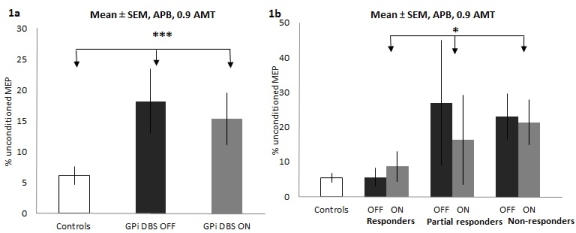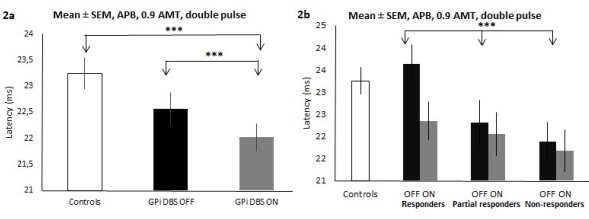Session Information
Date: Thursday, June 23, 2016
Session Title: Dystonia
Session Time: 12:00pm-1:30pm
Location: Exhibit Hall located in Hall B, Level 2
Objective: To distinguish between patients with dystonia according to the clinical outcome of pallidal stimulation (GPi DBS) using intracortical inhibition of the motor cortex assessed by paired transcranial magnetic stimulation (TMS).
Background: GPi DBS is an effective treatment for dystonic syndromes with a relatively high variability of clinical benefit. Patients with dystonia typically have a lower ability to suppress unwanted movements. Therefore we expected a decreased intracortical inhibition of motor cortex in these patients, which can be potentially reversed by GPi DBS.
Methods: We examined 22 patients (mean age 51±(SD)17 years) with dystonia of various distribution and origin treated by GPi DBS in different time intervals from implantation
| Patient | Age at onset | Body distribution | Etiology | Duration of GPi DBS (years) | BFMDS/TWSTRS before surgery | BFMDS/TWSTRS GPi DBS ON | Responsiveness |
|---|---|---|---|---|---|---|---|
| 1 | Late adulthood | Generalized | Idiopathic | 4 | 39 | 28.5 | Partial responder |
| 2 | Childhood | Generalized | DYT 1 | 6 | 27 | 2.5 | Responder |
| 3 | Early adulthood | Generalized | Idiopathic | 3 | 50 | 22.5 | Responder |
| 4 | Childhood | Generelized | Postanoxic | 1 | 47.5 | 46 | Non-responder |
| 5 | Childhood | Generelized | DYT 1 | 5 | 28.5 | 14 | Responder |
| 6 | Childhood | Generelized | PKAN | 9 | 77.5 | 55 | Partial responder |
| 7 | Childhood | Generelized | PKAN | 8 | 70.5 | 80 | Non-responder |
| 8 | Infancy | Generelized | Postanoxic | 3 | 50.5 | 47.5 | Non-responder |
| 9 | Late adulthood | Generelized | Idiopathic | 4 | 15 | x | Non-responder |
| 10 | Late adulthood | Generelized | Idiopathic | 3 | 8 | 0 | Responder |
| 11 | Late adulthood | Generelized | Idiopathic | 5 | 20.5 | 7 | Responder |
| 12 | Early adulthood | Generelized | Idiopathic | 6 | 29 | 24.5 | Non-responder |
| 13 | Late adulthood | Generelized | Idiopathic | 2 | 33 | 13.5 | Responder |
| 14 | Late adulthood | Generelized | Idiopathic | 3 | 21 | 12.5 | Partial responder |
| 15 | Late adulthood | Generelized | Possible MSA-P | 1 | 16.6 | 15.5 | Non-responder |
| 16 | Early adulthood | Cervical | Idiopathic | 4 | 24 | 17 | Partial responder |
| 17 | Early adulthood | Cervical | Idiopathic | 4 | 20 | 16 | Non-responder |
| 18 | Late adulthood | Cervical | Idiopathic | 1 | 26 | 22 | Non-responder |
| 19 | Early adulthood | Cervical | Idiopathic | 5 | 24 | 5 | Responder |
| 20 | Late adulthood | Cervical | Idiopathic | 3 | 25 | 22 | Non-responder |
| 21 | Childhood | Cervical | Idiopathic | 4 | 29 | 6 | Responder |
| 22 | Early adulthood | Cervical | Idiopathic | 7 | 24 | 14 | Partial responder |
Results: The SICI was less effective in patients than in controls regardless of the ON and OFF conditions (p<0.001). Non-responders (n=9; <25% CE) showed abnormally low SICI, partial responders (n=5; 25%-50% CE) showed higher SICI and the highest SICI was in responders (n=8; >50% CE, p<0.05). The MEP onset latency was shorter in patients in GPi DBS ON than in OFF condition (p<0.001). In addition, the shortest MEP onset latency was observed in non-responders, followed by partial responders and responders (p<0.001).
The MEP onset latency was shorter in patients in GPi DBS ON than in OFF condition (p<0.001). In addition, the shortest MEP onset latency was observed in non-responders, followed by partial responders and responders (p<0.001).
Conclusions: Our results suggest that the best responders to chronic GPi DBS treatment exhibited a similar level of intracortical inhibition as in healthy controls. On the contrary, non-responders were unable to increase their reduced cortical inhibition and effectively suppressed dystonic symptoms. We speculate that decreased intracortical inhibition with abnormally fast transmission volley in these patients is underpinned by the poor complexity of the motor network. Supported by the grant IGA MZ CR NT12282-5/2011.
To cite this abstract in AMA style:
A. Fecíková, V. Cejka, V. Capek, F. Ruzicka, V. Bocek, D. Štastná, I. Štetkárová, D. Urgošík, R. Jech. Clinical effects of pallidal stimulation in dystonia are quantitatively related to intracortical inhibition [abstract]. Mov Disord. 2016; 31 (suppl 2). https://www.mdsabstracts.org/abstract/clinical-effects-of-pallidal-stimulation-in-dystonia-are-quantitatively-related-to-intracortical-inhibition/. Accessed October 21, 2025.« Back to 2016 International Congress
MDS Abstracts - https://www.mdsabstracts.org/abstract/clinical-effects-of-pallidal-stimulation-in-dystonia-are-quantitatively-related-to-intracortical-inhibition/
